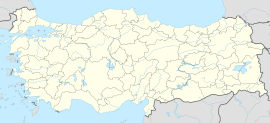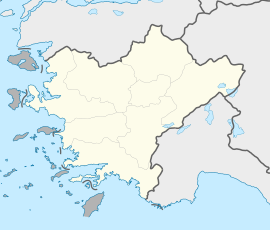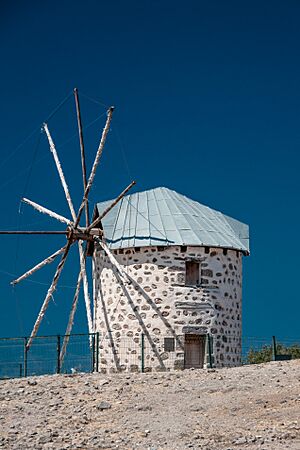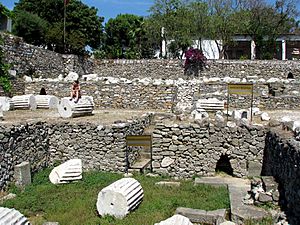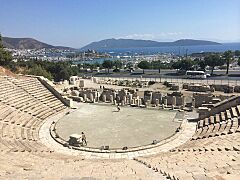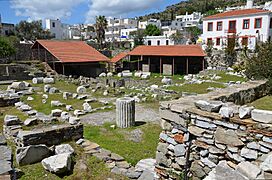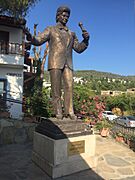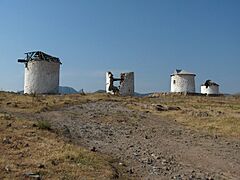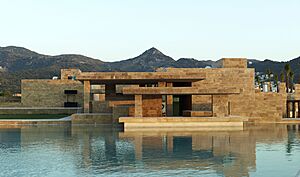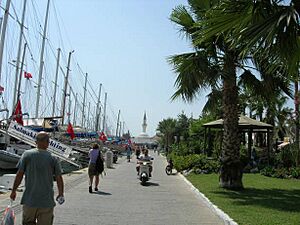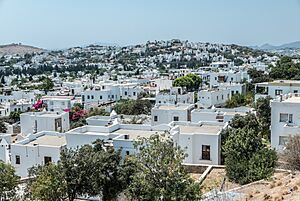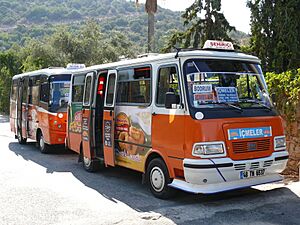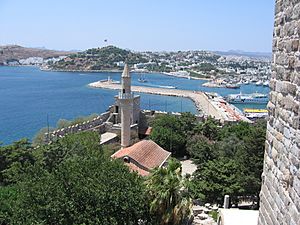Bodrum facts for kids
Quick facts for kids
Bodrum
|
|
|---|---|
|
Settlement
|
|
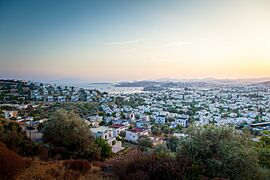 |
|
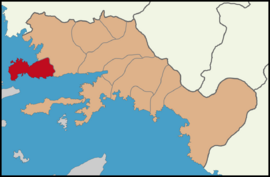
Map showing Bodrum District in Muğla Province
|
|
| Country | Turkey |
| Province | Muğla |
| Area | 650 km2 (250 sq mi) |
| Population
(2023)
|
198,335 |
| • Density | 305.1/km2 (790/sq mi) |
| Time zone | TRT (UTC+3) |
| Postal code |
48400
|
| Area code | 0252 |
Bodrum is a lively city and district in Muğla Province, Turkey. It's home to about 200,000 people and covers an area of 650 square kilometers. Bodrum is a port city located at the entrance to the Gulf of Gökova.
Long ago, this city was known as Halicarnassus. It was famous for being the home of the Mausoleum at Halicarnassus. This grand tomb was built for a ruler named Mausolus and was considered one of the Seven Wonders of the Ancient World.
The city was first settled by Dorian Greeks. Over time, it came under Persian rule and became the capital of the satrapy (a type of province) called Caria. Mausolus ruled Caria from here. After his death in 353 BC, his wife Artemisia built the famous Mausoleum for him.
Later, Macedonian forces led by Alexander the Great captured the city in 334 BC. After Alexander's death, Bodrum was ruled by different Hellenistic kings. It was even an independent kingdom for a short time. In 129 BC, it became part of the Roman Empire.
Over the years, natural disasters and pirate attacks caused a lot of damage. By the time of the Byzantine era, the city had lost much of its importance. In 1402, the Knights Hospitaller arrived. They used stones from the ruined Mausoleum to build the impressive Bodrum Castle. In 1522, the city became part of the Ottoman Empire.
For a long time, Bodrum's economy relied on fishing and sponge diving. However, since the late 20th century, tourism has become the main industry. Many visitors come to Bodrum, which has also boosted its shops and services. You can fly to Milas–Bodrum Airport or Kos International Airport to reach the city. Ferries connect Bodrum to nearby Turkish and Greek islands, like Kos. Local share taxis and buses are the main ways to get around.
Contents
What's in a Name?
The name Bodrum comes from the city's old medieval name, Petronium. This name is linked to the Hospitaller Castle of St. Peter.
In ancient times, Bodrum was called Halicarnassus. This was a very important city in ancient Caria. The name Halicarnassus might have come from an even older, non-Greek language. Some believe the part -karnassos is related to a word meaning "fortress" in the ancient Luwian language.
A Journey Through Time
Ancient Halicarnassus
Halicarnassus was an ancient Greek city where Bodrum stands today. It was founded by Dorian Greeks. Coins from that time show figures like Medusa, Athena, and Poseidon. This suggests its founders came from cities like Troezen and Argos.
Halicarnassus was once part of a group of six Dorian cities called the Doric Hexapolis. But it was removed from this group. This happened because one of its citizens did not follow a tradition during a sports event.
In the early 5th century BC, Artemisia I of Caria ruled Halicarnassus. She became famous as a naval commander in the battle of Salamis. Later, a ruler named Lygdamis II forced the famous historian Herodotus to leave the city around 457 BC. Herodotus is one of the most well-known people from Halicarnassus.
Under Persian Rule
After a while, the city came under the control of the Persian Empire. Under the Persians, Halicarnassus became the capital of Caria. This was a very important location because it was the main port for the region. Because of its key position, the city had a lot of freedom.
Mausolus ruled Caria from Halicarnassus. He was a powerful ruler, even though he was officially under Persian control. He ruled from 377 to 353 BC. When he died, his sister and wife, Artemisia II of Caria, decided to build a magnificent tomb for him. She hired famous Greek architects and sculptors for this project.
This tomb was so grand that the word "mausoleum" comes from its name. It looked like a temple with beautiful carvings and statues, built on a huge base. Today, only the foundations and a few pieces of its sculptures remain.
Later Empires: Greeks and Romans
Alexander the Great attacked and captured the city in 334 BC. He was helped by Queen Ada of Caria. After Alexander's death, different rulers took control of Bodrum. These included Antigonus I, Lysimachus, and the Ptolemies. For a short time, it was even an independent kingdom.
In 129 BC, Bodrum became part of the Roman Empire. Sadly, a series of earthquakes damaged much of the city, including the great Mausoleum. Pirates also attacked the area many times. By the early Byzantine era, Halicarnassus was an important religious center. But not much was left of its former glory.
Medieval Times
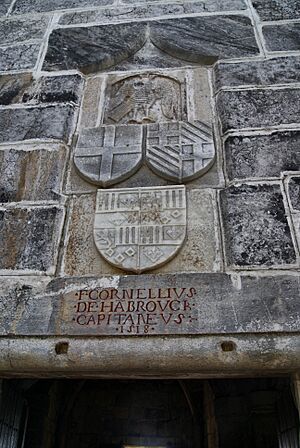
In 1402, Crusader Knights arrived in Bodrum. They used the stones from the ruined Mausoleum to build the impressive Bodrum Castle. This castle, also known as the Castle of Saint Peter, is a great example of Crusader architecture. The Knights Hospitaller were allowed to build it by the Ottoman sultan Mehmed I. This happened after their previous fortress in İzmir was destroyed.
In 1522, Suleiman the Magnificent conquered the Knights' main base on the island of Rhodes. The Knights then moved to Europe. This left the Castle of Saint Peter and Bodrum to the Ottoman Empire.
Modern Bodrum
Until the early 20th century, Bodrum was a quiet town. Its main jobs were fishing and sponge diving. Modern sponge diving became popular after people from Kos and Crete settled in Bodrum in the 1920s. Between 1945 and 1965, about 150 boats were involved in sponge diving. However, diseases affecting sponges and the creation of artificial sponges eventually ended this business.
Over the years, tourism grew to be the most important activity and source of income for Bodrum. The many visitors have also helped the shops and service businesses in the city. Leather goods, especially traditional woven sandals, are popular products. Other traditional items like tangerine-flavored Turkish delight and nazar amulets are popular souvenirs.
Weather in Bodrum
Bodrum has a hot summer Mediterranean climate. This means it has very hot and sunny summers, and mild, wet winters. The average temperature is around 15°C (59°F) in winter and 34°C (93°F) in summer. The highest temperature ever recorded was 46.8°C (116.2°F) in July 2017.
| Climate data for Bodrum (1970-2011) | |||||||||||||
|---|---|---|---|---|---|---|---|---|---|---|---|---|---|
| Month | Jan | Feb | Mar | Apr | May | Jun | Jul | Aug | Sep | Oct | Nov | Dec | Year |
| Record high °C (°F) | 23.1 (73.6) |
24.0 (75.2) |
28.7 (83.7) |
30.8 (87.4) |
39.0 (102.2) |
42.3 (108.1) |
46.8 (116.2) |
45.0 (113.0) |
39.8 (103.6) |
38.9 (102.0) |
31.0 (87.8) |
24.5 (76.1) |
46.8 (116.2) |
| Mean daily maximum °C (°F) | 15.2 (59.4) |
15.2 (59.4) |
17.6 (63.7) |
21.1 (70.0) |
26.0 (78.8) |
31.2 (88.2) |
34.2 (93.6) |
34.0 (93.2) |
30.3 (86.5) |
25.6 (78.1) |
20.3 (68.5) |
16.5 (61.7) |
23.9 (75.1) |
| Daily mean °C (°F) | 11.4 (52.5) |
11.3 (52.3) |
13.2 (55.8) |
16.4 (61.5) |
20.9 (69.6) |
25.7 (78.3) |
28.3 (82.9) |
28.0 (82.4) |
24.5 (76.1) |
20.3 (68.5) |
15.8 (60.4) |
12.7 (54.9) |
19.0 (66.3) |
| Mean daily minimum °C (°F) | 8.3 (46.9) |
8.1 (46.6) |
9.7 (49.5) |
12.7 (54.9) |
16.5 (61.7) |
20.8 (69.4) |
23.3 (73.9) |
23.3 (73.9) |
20.3 (68.5) |
16.8 (62.2) |
12.8 (55.0) |
9.8 (49.6) |
15.2 (59.3) |
| Record low °C (°F) | −1.6 (29.1) |
−4.5 (23.9) |
−1.8 (28.8) |
2.8 (37.0) |
8.0 (46.4) |
12.6 (54.7) |
16 (61) |
18.5 (65.3) |
10.8 (51.4) |
7.8 (46.0) |
2.0 (35.6) |
0.2 (32.4) |
−4.5 (23.9) |
| Average precipitation mm (inches) | 134.1 (5.28) |
107.9 (4.25) |
74.0 (2.91) |
39.1 (1.54) |
18.4 (0.72) |
7.5 (0.30) |
1.3 (0.05) |
8.5 (0.33) |
20.8 (0.82) |
40.5 (1.59) |
97.7 (3.85) |
156.2 (6.15) |
706 (27.79) |
| Average rainy days | 12.3 | 11.2 | 8.5 | 6.9 | 3.7 | 2.1 | 1.5 | 1.0 | 2.8 | 5.3 | 8.8 | 13.2 | 77.3 |
| Mean monthly sunshine hours | 148.8 | 151.2 | 198.4 | 225 | 285.2 | 318 | 337.9 | 322.4 | 273 | 223.2 | 168 | 139.5 | 2,790.6 |
| Source: Devlet Meteoroloji İşleri Genel Müdürlüğü | |||||||||||||
| Climate data for water temperatures in Bodrum | |||||||||||||
|---|---|---|---|---|---|---|---|---|---|---|---|---|---|
| Month | Jan | Feb | Mar | Apr | May | Jun | Jul | Aug | Sep | Oct | Nov | Dec | Year |
| Mean daily maximum °C (°F) | 18.5 (65.3) |
17.0 (62.6) |
16.6 (61.9) |
18.2 (64.8) |
21.0 (69.8) |
24.5 (76.1) |
26.8 (80.2) |
27.4 (81.3) |
26.8 (80.2) |
25.3 (77.5) |
22.0 (71.6) |
19.8 (67.6) |
22.0 (71.6) |
| Mean daily minimum °C (°F) | 15.2 (59.4) |
14.9 (58.8) |
15.2 (59.4) |
15.3 (59.5) |
17.6 (63.7) |
21.0 (69.8) |
23.1 (73.6) |
24.5 (76.1) |
23.7 (74.7) |
20.0 (68.0) |
17.2 (63.0) |
15.7 (60.3) |
18.6 (65.5) |
| Source: seatemperature.org | |||||||||||||
Top Places to See
The Castle of St. Peter is one of the most popular attractions. The Knights Hospitaller built this castle in the 15th century. They used stones from the ruins of the Mausoleum to construct its walls. The castle still looks much like it did when the Knights built it, showing off Gothic architecture.
Inside the castle, you'll find the Bodrum Museum of Underwater Archaeology. This museum was opened in 1962. It displays amazing discoveries from ancient shipwrecks found in the Aegean Sea. In 2016, the castle was added to Turkey's list of possible World Heritage Sites. The castle has been under renovation since 2017, but some parts are still open to visitors.
The ruins of the Mausoleum at Halicarnassus are also a major sight. This famous tomb was built in the fourth century BC. It was designed by Greek architects for Mausolus, a ruler of the Persian Empire, and his sister-wife Artemisia II of Caria. The Mausoleum was one of the Seven Wonders of the Ancient World. By the 12th century CE, most of it was destroyed. Today, its ruins still attract many tourists. There are plans to turn the ruins into an open-air museum.
Besides the Bodrum Museum of Underwater Archaeology, there are other museums. The Zeki Müren Art Museum is dedicated to the famous Turkish classical musician Zeki Müren. His house in Bodrum became a museum after he passed away. The Bodrum Maritime Museum focuses on the city's history with the sea. It collects and displays historical items related to Bodrum's maritime past. The Bodrum City Museum is a smaller museum in the city center. It shares the general history of the Bodrum peninsula.
People of Bodrum
| District population | ||||||||||||||||||||||||||||||||||||||||
|---|---|---|---|---|---|---|---|---|---|---|---|---|---|---|---|---|---|---|---|---|---|---|---|---|---|---|---|---|---|---|---|---|---|---|---|---|---|---|---|---|
|
|
|||||||||||||||||||||||||||||||||||||||
| Source: Population censuses (1965-1997) and TÜIK (2007-2022) | ||||||||||||||||||||||||||||||||||||||||
Bodrum's Economy
In the 20th century, Bodrum's economy mainly depended on fishing and sponge diving. Sponge diving has a long history in the Aegean region, going back at least 3,000 years. It became very popular in Bodrum after immigrants from Kos and Crete settled there in the 1920s. Between 1945 and 1965, about 150 boats were involved in sponge diving. However, sponge diseases and the invention of artificial sponges eventually led to the end of this industry.
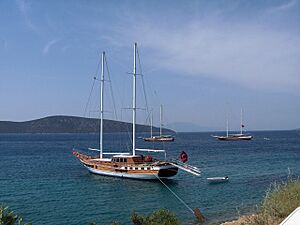
Over the years, tourism became the main source of income for Bodrum. The large number of visitors has also helped the retail and service industries. Bodrum is known for its leather goods, especially traditional woven sandals. Other popular souvenirs include tangerine-flavored Turkish delight and nazar amulets.
Besides small shops, Bodrum has a few shopping malls like Midtown and Oasis. There are also several marinas for yachts and ships. These include Milta Bodrum Marina, D-Marin Turgutreis, and the award-winning Yalıkavak Marina.
The Carian Trail, a hiking path, passes through Bodrum and nearby ancient ruins. This trail attracts hikers from both Turkey and other countries.
Culture and Style
Bodrum's Architecture
Traditional houses in Bodrum have simple, box-like shapes. They are built using local materials like stone, wood, clay, and cane. Most importantly, their outer walls are usually white with some blue details, like doors and windows.
The tradition of white-washed walls is not just for looks. The lime in white paint helps keep away bugs and scorpions. White paint also reflects heat, which is helpful in hot regions. The blue color is believed by locals to protect against bad luck or envy.
To get a building permit in Bodrum, you must agree to paint the new building's walls white. This rule helps protect the city's unique historical look and cultural identity.
Fun Events and Festivals
The Bodrum International Ballet Festival takes place every summer since 2002. Bodrum has also hosted the Bodrum International Biennial since 2014. The Bodrum Baroque Music Festival is another yearly music event held in the city.
Getting Around Bodrum
Airports Near Bodrum
There are no civilian airports directly within Bodrum's district. The main airports serving the city are Milas–Bodrum Airport and Kos Island International Airport. Milas–Bodrum Airport is about 36 kilometers northeast of Bodrum. It has both domestic and international flights. Kos Island International Airport is about 70 kilometers southwest, in Greece. You can reach it by boat from Bodrum across the Aegean Sea. Kos airport has flights mostly during the tourist season.
An older airport, Bodrum-Imsik Airport, used to serve the city. But it closed to commercial flights in the late 1990s. It is now used as an air base.
Bus and Dolmuş
The main bus station in Bodrum used to be in the city center. But in 2021, it moved to a new facility in Torba, about 6 kilometers away. This move helps reduce traffic jams in the city center during busy times. The old bus station still handles buses within the district. But longer-distance buses to other parts of Turkey now use the new station. The new station uses solar power and has electric car charging units.
Most public transportation in Bodrum uses local shared taxis called "dolmuş". These are privately owned minibuses that show their route on signs. The word "dolmuş" means "full" in Turkish. This is because these shared taxis only leave when they have enough passengers. The Muğla Municipality also has scheduled bus services between towns on the Bodrum peninsula. Buses run non-stop between major towns like Gümbet, Bitez, Turgutreis, and the main bus station.
Bodrum's Ports
Bodrum's port has ferries that connect to other nearby Turkish and Greek ports and islands. Bodrum also has three large marinas and places for cruise ships. The first marina, Milta, is in the center of Bodrum. The second marina is in Turgutreis. The third, Palmarina, is in Yalıkavak.
Yalıkavak Marina is a luxury marina near Bodrum. It has become a popular spot for large yachts.
Wildlife in Bodrum
The typical plants of the Mediterranean climate, called Maquis shrubland biome, are common in Bodrum, especially near the coast. Forests cover a large part (61.3%) of the district. Common trees include pines, larches, cedars, and junipers.
Forests in the area are often affected by wildfires. These fires are common in Bodrum's history. Most forest fires in Turkey are believed to be caused by human activities. There are concerns that some forests are intentionally set on fire to make space for new buildings.
Wild boars and foxes live in the area. Other animals you might see include pygmy cormorants, Dalmatian pelicans, and lesser kestrels. The region is also home to the Mediterranean monk seal, which is an endangered and protected animal.
Famous People from Bodrum
- Herodotus – an ancient Greek historian
- Scylax of Caryanda – an ancient explorer
- Mausolus – a powerful Carian ruler
- Artemisia II of Caria – a Carian ruler and sister-wife of Mausolus
- Dionysius – an ancient Greek historian and teacher
- Turgut Reis – a famous Ottoman Turkish admiral
- Halikarnas Balıkçısı ('The Fisherman of Halicarnassus') – a Turkish writer who lived in Bodrum for many years
- Zeki Müren – a beloved Turkish singer who also lived in Bodrum for decades
Sister Cities
Bodrum has special connections with other cities around the world. These are called twin towns or sister cities:
See also
 In Spanish: Bodrum para niños
In Spanish: Bodrum para niños


